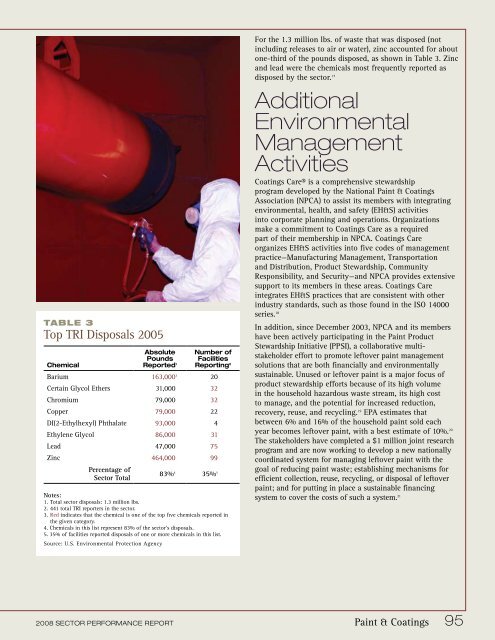2008 Sector Performance Report - US Environmental Protection ...
2008 Sector Performance Report - US Environmental Protection ...
2008 Sector Performance Report - US Environmental Protection ...
You also want an ePaper? Increase the reach of your titles
YUMPU automatically turns print PDFs into web optimized ePapers that Google loves.
Table 3<br />
Top TRI Disposals 2005<br />
Absolute Number of<br />
Pounds Facilities<br />
Chemical <strong>Report</strong>ed 1 <strong>Report</strong>ing 2<br />
Barium 163,000 3 20<br />
Certain Glycol Ethers 31,000 32<br />
Chromium 79,000 32<br />
For the 1.3 million lbs. of waste that was disposed (not<br />
including releases to air or water), zinc accounted for about<br />
one-third of the pounds disposed, as shown in Table 3. Zinc<br />
and lead were the chemicals most frequently reported as<br />
17<br />
disposed by the sector.<br />
Additional<br />
<strong>Environmental</strong><br />
Management<br />
Activities<br />
Coatings Care® is a comprehensive stewardship<br />
program developed by the National Paint & Coatings<br />
Association (NPCA) to assist its members with integrating<br />
environmental, health, and safety (EH&S) activities<br />
into corporate planning and operations. Organizations<br />
make a commitment to Coatings Care as a required<br />
part of their membership in NPCA. Coatings Care<br />
organizes EH&S activities into five codes of management<br />
practice—Manufacturing Management, Transportation<br />
and Distribution, Product Stewardship, Community<br />
Responsibility, and Security—and NPCA provides extensive<br />
support to its members in these areas. Coatings Care<br />
integrates EH&S practices that are consistent with other<br />
industry standards, such as those found in the ISO 14000<br />
series. 18<br />
In addition, since December 2003, NPCA and its members<br />
have been actively participating in the Paint Product<br />
Stewardship Initiative (PPSI), a collaborative multistakeholder<br />
effort to promote leftover paint management<br />
solutions that are both financially and environmentally<br />
sustainable. Unused or leftover paint is a major focus of<br />
product stewardship efforts because of its high volume<br />
in the household hazardous waste stream, its high cost<br />
to manage, and the potential for increased reduction,<br />
Copper 79,000 22 recovery, reuse, and recycling. 19 EPA estimates that<br />
DI(2-Ethylhexyl) Phthalate 93,000 4 between 6% and 16% of the household paint sold each<br />
Ethylene Glycol 86,000 31 year becomes leftover paint, with a best estimate of 10%. 20<br />
The stakeholders have completed a $1 million joint research<br />
Lead 47,000 75<br />
program and are now working to develop a new nationally<br />
Zinc 464,000 99 coordinated system for managing leftover paint with the<br />
Percentage of<br />
<strong>Sector</strong> Total<br />
83% 4 35% 5<br />
Notes:<br />
1. Total sector disposals: 1.3 million lbs.<br />
2. 441 total TRI reporters in the sector.<br />
3. Red indicates that the chemical is one of the top five chemicals reported in<br />
the given category.<br />
4. Chemicals in this list represent 83% of the sector’s disposals.<br />
5. 35% of facilities reported disposals of one or more chemicals in this list.<br />
Source: U.S. <strong>Environmental</strong> <strong>Protection</strong> Agency<br />
goal of reducing paint waste; establishing mechanisms for<br />
efficient collection, reuse, recycling, or disposal of leftover<br />
paint; and for putting in place a sustainable financing<br />
system to cover the costs of such a system. 21<br />
<strong>2008</strong> SECTOR PERFORMANCE REPORT<br />
Paint & Coatings 95















